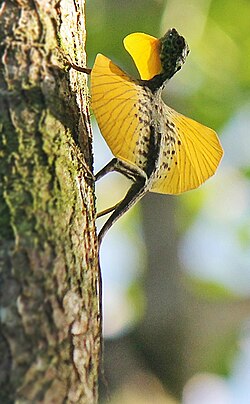| Draco spilonotus | |
|---|---|
 | |
| Scientific classification | |
| Kingdom: | Animalia |
| Phylum: | Chordata |
| Class: | Reptilia |
| Order: | Squamata |
| Suborder: | Iguania |
| Family: | Agamidae |
| Genus: | Draco |
| Species: | D. spilonotus |
| Binomial name | |
| Draco spilonotus Günther, 1872 | |
 | |
| Synonyms [1] | |
Draco lineatus spilonotus | |
Draco spilonotus, the Sulawesi lined gliding lizard, [2] is a lizard endemic to Sulawesi. [1] [3] The species is known from various localities in forested areas of Sulawesi. [2]
Contents
The patagium of the male is yellow in colour and has a network of brown lines radiating from the anterior. The gular flag is yellow and rounded in shape. [2]